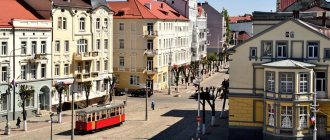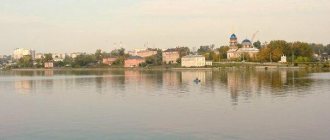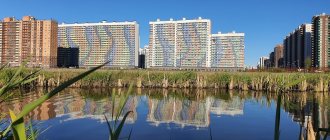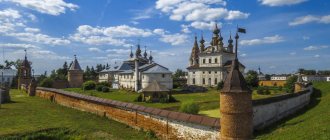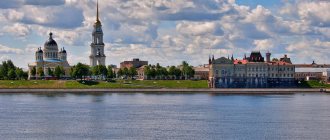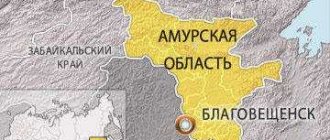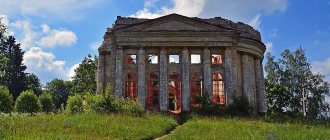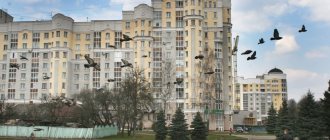The Shchekinskoe (Sovetskoye) reservoir appeared in the Sovetsky district of the Tula region in 1950. An artificial pond was created to cool the heated water that was used in the water supply system of the Shchekinskaya State District Power Plant. Since 2015, the reservoir is no longer a cooling pond, since its “duties” are performed by special technical structures on the territory of the power plant.
Today, the Soviet Reservoir performs only a recreational function, which was “assigned” to the reservoir almost immediately after its creation. Every year thousands of vacationers from all over the Tula region come here to have a picnic, sunbathe on the beach or fish.
The picturesque shores of the Soviet Reservoir, © Yulia Bobkova
History[edit]
The construction of the settlement during the construction of the Shchekinskaya State District Power Plant near the village of Kryukovka began in 1947. The first 7 buildings housed the construction department, the directorate of the State District Power Plant, a telephone exchange, a canteen and a store.
On October 26, 1949, he was classified as a worker and received the name Soviet.
On October 31, 1954, the village of Sovetsky was reorganized into the city of regional subordination of Sovetsk. The village of Upinsky is included within the city limits.
Since 2006, it has been part of the municipal formation “Sovetsk City” as part of the Shchekinsky district.
The mystery of the disaster near Sovetsk
Tula extreme sports enthusiast Dmitry Kozlov found a mysterious structure near Tula, littered with animal skulls and cemetery plaques.
FORT IN THE FOREST Dmitry found a mysterious place in the north-west of Sovetsk, Shchekinsky district. “I play the night game “Watch” and once, while preparing one of the tasks, I explored the surroundings of the Shchekinskaya State District Power Plant,” says Dima. — In a landing about 5 km from Sovetsk, I came across an abandoned building. The four-story, round concrete structure is somewhat reminiscent of a naval fort! The dozens of gaping empty windows throughout the building made an eerie impression. Together with my friends, I decided to check what was inside. It turned out that several floors above the ground are not all. The tower goes deep into the earth and consists of spans 10 meters high each. The adventure hunters had to descend into the dungeon through rotten brackets mounted in the walls. “The lower we went, the more interesting it became how deep the lower levels of the structure are,” continues Dmitry. — The situation on the underground floors was terrible. There is rust everywhere, debris from collapsed spans, and pitch darkness—every chance something will fall under your feet or collapse from above. I had to check every step and every movement! I felt like a miner going down into the face, or a real metropolitan digger! (Smiles).
5 km northwest of Sovetsk, Shchekinsky district. Even in summer, grass doesn’t grow here, and the trees stand dry...
UNDERGROUND CEMETERY On one of the levels, at a depth of about 20 meters, Dmitry and his friends found creepy things - several plaques and photographs from graves! The guys found scattered animal skulls and bones on several floors. “These skulls are very large,” says the Tula man. - Most likely, these are the remains of horses or cows. We suffered fear for several months in advance - something crunches under our feet, you shine a flashlight, and there are bones: Anyone’s knees would shake! The descent ended at a depth of 50 meters. According to Dmitry, the last level of the tower was flooded: “Water poured from above like a solid wall, like a waterfall!” From where, we still don’t understand. Two tunnels ran off to the side from the lower floor. Having changed into swampers, we walked along one of them for 100 meters, but did not dare to go further - the water was very cold.
In a mine, Tula resident Dmitry Kozlov photographed a ghost with his camera.
A mysterious face appeared in the cloud of steam.
A GHOST LIVES IN THE MINE Tula diggers photographed everything they saw. In one of the photographs after the expedition, the guys saw someone’s face! “This photo was taken at the lowest level,” says Vladimir Miller, a Tula “watchman.” — A cloud of steam from our breath was reflected in the foreground of the photo. It was in this very cloud that a human face appeared! In the photo, which the adventurers gave to Sloboda correspondents, facial features are really clearly visible. In the center of the frame, a little closer to the left edge, the oval line of the person’s face, lips, nose and eyes are visible. Is this a coincidence, or did the Tula residents really manage to capture a ghost living in a dungeon next to cemetery plaques and animal skeletons?
In the dungeon, Tula diggers found the skull of some animal.
On the underground floor of the tower there are photographs from tombstones...
... and cemetery plaques.
TECHNOLOGICAL DISASTER? — The forest planting in which the structure stands consists of young birch trees, black ash soil, crunchy underfoot, and nothing else. “No trees, no bushes, no grass,” says Dmitry. “It’s as if everything here was burned out with fire!” There is a legend among Sovetsk residents that the spot surrounding the city on the western side is the result of a local man-made disaster. It was formed as a result of ash dumps from burned coal from the Shchekino hydroelectric power station. Locals say that the background radiation is increased in plantings growing on ash, and they avoid this place. But scientists have not confirmed this information. “Local residents are dramatizing the situation in vain,” employees of the Faculty of Mining and Construction of Tula State University told us. — We are talking about storing production waste. This is standard practice. The radiation background in this place is not exceeded: during radiation, rapid growth of vegetation is observed. So there can be no talk of any man-made disaster; residents can rest assured.
BY THE WAY, A MYSTERIOUS NEIGHBORHOOD A couple of kilometers from the mysterious tower, Sovetsk resident Valery Umnov discovered a strange cemetery (see “Sloboda” dated September 17, 2008). The man found a huge cross with icons and inscriptions at the intersection of two paths. Two steps from the cross is a cement embankment with two... galoshes sticking out of it! And five meters from this place there are a couple of small pits resembling graves. It turned out that the cross was erected by local women who from all over Sovetsk gathered in a small forest and grazed cattle there. And in order to have something to do, they erected a cross and prayed there.
Andrey VARENKOV.
Population[edit]
According to State Statistics Committee data as of January 1, 2021, 7,440 people live in Sovetsk. Sovetsk is the most sparsely populated city in the Tula region after Chekalin.
The male population, according to the 2010 All-Russian Population Census, is 43.7%, the female population is 56.3%.
| Year | Population | Year | Population | Year | Population | Year | Population | Year | Population |
| 1959 | 10 099 | 1970 | 11 024 | 1979 | 10 432 | 1989 | 10 077 | 1996 | 9800 |
| Year | Population | Year | Population | Year | Population | Year | Population | Year | Population |
| 1998 | 9500 | 2000 | 9100 | 2001 | 8800 | 2002 | 8770 | 2005 | 8400 |
| Year | Population | Year | Population | Year | Population | Year | Population | Year | Population |
| 2006 | 8100 | 2007 | 7900 | 2008 | 7700 | 2010 | 7536 | 2011 | 7500 |
| Year | Population | Year | Population | Year | Population | Year | Population | Year | Population |
| 2012 | 7442 | 2013 | 7452 | 2014 | 7363 | 2015 | 7347 | 2016 | 7360 |
| Year | Population | ||||||||
| 2017 | 7440 |
Sovetsk (Tula region)
District center:
Shchekino 10th October • Alimkina • Arsenyevo • Arkhangelskoye • Begichevo • Begichevo • Belovy Dvory • Beloguzovo • Bogoroditskie Dvoriki • Bolotovo • Bolshaya Brazhenka • Bolshaya Kozhukhovka • Bolshaya Mostovaya • Bolshaya Trosna • Bolshaya Khatunka • Bolshie Ozerki • Bolshoye Triznovo • Borisovka • Brodovka • Bukhonovo • Bukhonovsky • Verigino • Verkhnee Gaykovo • Verkhniye Sura • Vozremo • Vygorkovo • Golovenki • Golovenkovsky • Goloshchapovo • Mount Uslan • Gorodna • Goryachkino • Gremyachiy Kolodez • Gretsovka • Gretsovka • Grishinka • Grumant • Danilovka • Deminka • Industrial Plant Houses • Shakhty Houses No. 2-Zapadnaya • Dragoons • Druzhba • Elizavetinsky • Zherdevo • Zhilaya • Zhitovo-Glagolevo • Zhitovo-Dedovo • Zhitovo-Likhachevo • Zalesny • Zarechye • Zarya • Zakharovka • Zmeevo • Zubarevka • Zykovo • Ivanovka • Cossack • Cossack • Kaznacheevka • Kaznacheevsky • Kamenka • Kamenka • Kamenskie Vyselki • Karamyshevo • Klimovskoe • Kozlovka • Kozyulkinskie Vyselki • Koledino • Koroviki • Korchma • Kosoe • Kostomarovo • Kochaki • Krapivenskaya Sloboda • Krapivna • Krasnaya Slobodka • Krasnogorka • Krasnopolye • Red Hills • Red • Crosses • Krivtsovo • Krivtsovo-Solosovka • Krutovka • Krutovka • Krutoe • Kryukovka • Kryukovskoe Lesnichestvo • Kuzmino-Domozhirovo • Kuzmino-Kropotkino • Kukuevka • Kutepovka • Kutma • Lazarevo • Lanskoye • Lapino • Lapotkovo • Lesnoy • Lipovo • Lomintsevo • Lomintsevsky • Lomovka • Lukino • Lvovo • Lyapishchevo • Mayevka • Maisky • Maisky • Makeevka • Malakhovo • Malakhovo • Malaya Brazhenka • Malaya Kozhukhovka • Malaya Mostovaya • Malaya Khatunka • Maloe Triznovo • Malye Ozerki • Malyn • Marmyzhi • Minino • Mikhailovka • Moskovskaya • Moscow Vyselki • Mostovskoy • Museum- Estate L.N.
Tolstoy • Myasnovka • Myasnovka • Myasoyedovo • Nagorny • Natalevka • Naumovka • Neratnoye • Nizhnee Gaykovo • Nizhniye Sura • Nikolaevka • Nikolaevka • Nikolskoye • Novoe Rusanovo • Novonikolskoye • Novoselki • New Vyselki • Novy Mir • Novy Park • Obraztsovo • Ogarevka • Ogarevka • Oktyabrsky • Orlovo • Ostrovsky • Pavlovo • Panarino • Pervomaisky • Perevoloki • Perevoloki-Vozratnye • Petrovskoye • Pirogovka-Sokovnino • Pirogovka-Ulyanovka • Pirogovo 1st • Pirogovo 2nd • Pirogovo-Zykovo • Podivankovo • Polzovo • Potemkino • Privolye • Prishnya • Proskurino • Forgiven Well • Ponds • Ponds • Pushkarskaya • Pushkarskie Vyselki • Pushkino • Razdolye • Redoch • Retinka • River-Krapivenka • Rzhavo • Drovka 1st • Drovki 2nd • Rudny • Rusinovka • Ryazanovka • Sadovyi • Samokhvalovka • Satinka • Svoboda • Selivanovo • Semenovsky • Skvortsovo • Skorodumovo • Smirnoe • Sovetsk • Solova • Solomasovo • Sorochinka • Socialist • Spassky • Spassky • Spitsino • Zhitovo Station • Lazarevo Station • Sumarokovo Station • Shevelevka Station • Staraya Kolpna • Staraya Krapivenka • Old Rusanovo • Starye Vyselki • Stakhanovo • Stublevka • Sukromenka • Sumarokovo • Supruty • Telezhinka • Vealinki • Terenino • Technical • Tours • Umcheno • Ust-Kolpna • Fominka • Kharino • Khmelevets-Bystry • Khmelevets-Kryukovo • Ozerki Khutor • Tsarevo • Central • Chermoshnya • Chirikovo • Shakhtarsky • Shakhty-20 • Shakhty-21 • Shakhty-22 • Shakhty-24 • Shakhty-25 • Shevelevka • Shlykovo • Shmygalovka • Shushkovo • Shchekino village • Yubileiny • Yuryevka • Yagodnoye • Yankovo • Yartsevo • Yasenki • Yasenki • Yasnaya Polyana • Yasnaya Polyana • Yastrebovka
Rest
Residents of Sovetsk chose the western shore of the reservoir for recreation. Previously, there was a thriving dacha union “Voskhod” here, but recently the village has fallen into complete disrepair, and the well-trodden approaches to the shore are overgrown with bushes and reeds.
Vacationers are not bothered by the lack of infrastructure. They come to the Shchekinskoye Reservoir for almost 6 months a year - from mid-spring until the onset of cold weather. The greatest influx of people occurs in the summer months, when the city beach opens.
Boat station, © Alexander U.
Beach on the Shchekinskoye Reservoir
In 2015, a free city beach appeared on the shore of the Shchekinsky (Soviet) reservoir next to the dam, which received the unofficial name “bathing”. In the summer, sun canopies and metal trash cans appear on the shore. The beach area is covered with imported river sand, which is renewed annually.
The swimming area is fenced in accordance with the requirements of the Ministry of Emergency Situations. Before the official opening of each season, the bottom is checked for the absence of snags and sharp objects. Volunteer lifeguards are on duty on the beach.
Depth and other characteristics
The cooling pond was built on the Upa River, the right tributary of the Oka. The reservoir is located south of three other Tula reservoirs (Shatsky, Lyubovsky, Cherepetsky), each of which is “tied” to a specific power plant.
© Sergey Sitnikov
In terms of size, the Sovetskoye Reservoir is in 3rd place - its water area is 586 hectares. This is a small figure: reservoirs with a surface area of less than 2,000 hectares are classified as small.
The Soviet reservoir can be roughly divided into two parts, one of which is located south of the dam, and the other extends to the north. The southern part is shaped like a cheesecake, the northern part is shaped like a vase with a slightly inclined neck. There is a large artificial island with a forest belt and garden areas.
The length of the Shchekinskoye reservoir is about 4.5 km. The distance from the shores to the island in different places reaches from 170 to 700 m. The depth begins 3–4 meters from the shore, where it reaches about 5–6 meters. The bottom is flat and mostly sandy - without snags, but with a small amount of silt.
Bridge to the island, © Sergey P.
Fishing in the Shchekinskoye Reservoir
For a long time, the Shchekinskoye (Sovetskoye) reservoir was considered one of the best fishing spots in the Tula region. More than 20 species of freshwater fish were found here, and fishermen easily caught more than 5 kg in one “run” with fishing rods and spinning rods. The catch could consist of crucian carp, ruff, perch, catfish, silver carp, and rudd.
Gradually, the species diversity of fish changed and became more modest. The results of recent research ichthyological surveys were disappointing. Thus, in 2007, small crucian carp predominated in the catches of fine-mesh nets (61%), and by 2013 its number decreased by almost 20 times (3.4%).
© Sergey Sitnikov
The main reason for the decline in the population of many fish species is eutrophication of the reservoir (excessive saturation with phosphorus compounds, nitrogen, and other nutrients), as a result of which the concentration of oxygen dissolved in water decreases. This process is closely related to the long-term supply of waste hot water through the circulation channel (circuit) of the state district power plant, which often received wastewater from the nearby SCA paper mill.
Today, using amateur gear you can catch roach, bleak, mustard, crucian carp, carp and perch. Occasionally channel catfish, chub and silver carp are caught. Fishermen cast fishing rods, donks and spinning rods mainly from the shore. Popular fishing spots are along the causeway and on the large artificial island.
Previously, the fishing season occurred only in the warm months, since in winter the surface of the reservoir was not covered with ice everywhere. Nowadays you can catch fish at any time of the year. When the discharge of hot water stopped, the reservoir began to completely freeze in winter.
© Veronica Bogdanova
